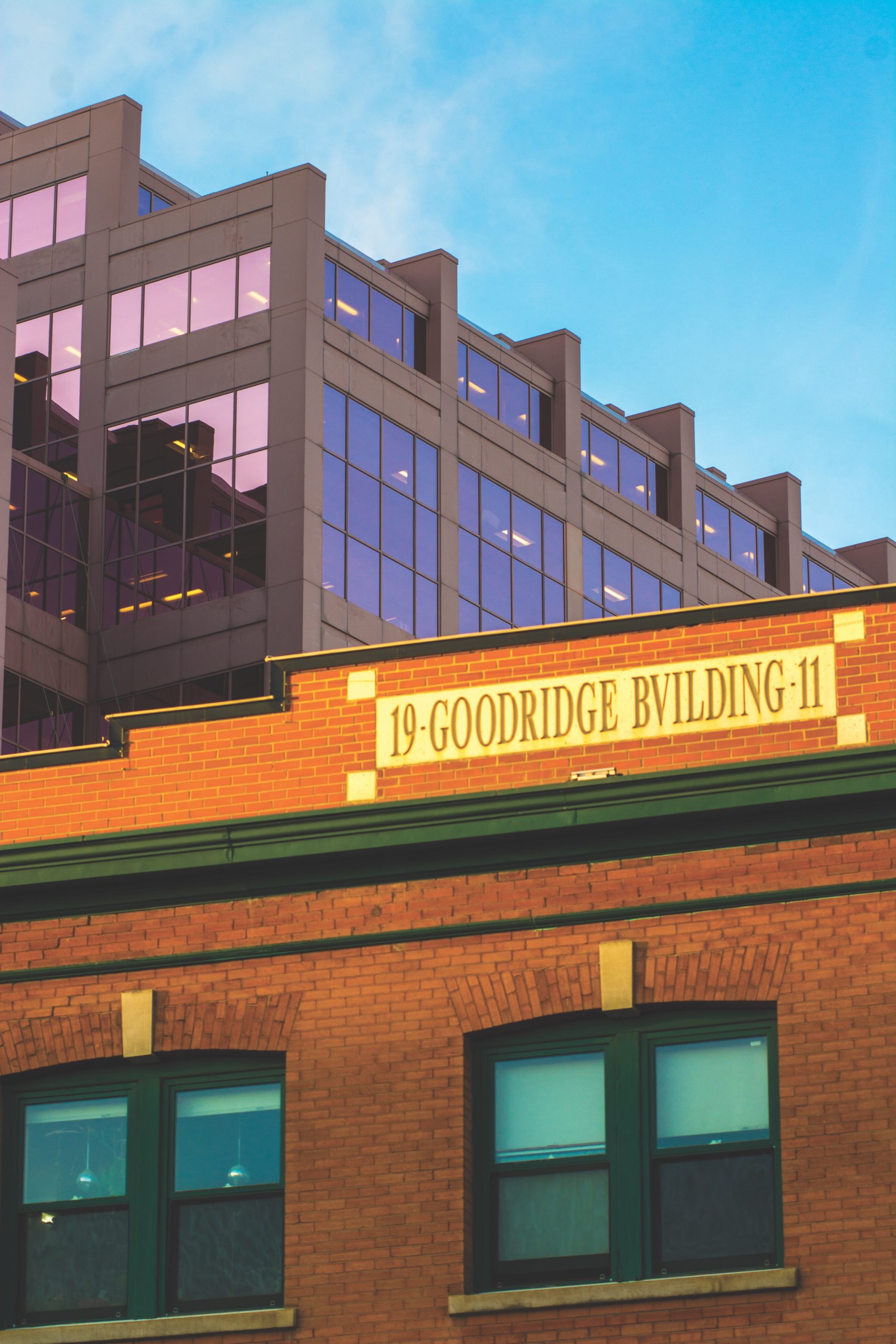Just inside the newly constructed lobby of the Brighton Block, right beside the main doors, there is a concrete wall curiously dotted with engravings of pigeon silhouettes.
“When we got this building, the wall that was here was so covered with pigeon poop that it had become structurally unsound,” says Adam Cantor, development manager for Primavera Development Group. “We wanted to commemorate it.”
Primavera started working on the Brighton Block after they purchased it in 2016, but the building’s history goes much further back than that.
It can be found by heading a little further east on Jasper Ave. than you typically might if you’re there for the usual purpose of patronizing the bustling restaurants or bars of Edmonton’s commercial centre — just on the other side of the giant pink glass partition that is Canada Place. You’ll find it among an entire block of old, red brick low-rises that stand in humble contrast to the shiny, glass-and-steel skyscrapers of the rapidly develop- ing downtown.
Almost every building on this little stretch of the avenue was built between 1882 and 1915, using an Edwardian style of architecture that was popular in the period, characterized by ornamented pressed-brick facades, decorative cornices, and parapets for painted signage — features which are scarcely found in modern construction. As such, six buildings on this one block have been given the designation of “Municipal Historic Resource” by the City of Edmonton, including the Brighton Block.
And it’s not just this row. The entire area, which is now called Boyle Street but was once Edmonton’s original downtown, is one of the oldest neighbourhoods in the city, and as such, has one of the high- est concentrations of historic buildings.
What you can’t see, obviously, are all the ones that have already been torn down.
“We have hardly any buildings from the original Edmonton left. They’ve all been taken out,” says Candas Jane Dorsey, a member of the Boyle Street Community League. “‘Heritage clear-cutting’ is what I call it.”

“We have hardly any buildings from the original Edmonton left. They’ve all been taken out.”
— Candas Jane Dorsey
Boyle Street has not escaped the urban renewal efforts that have taken over the city centre in the past few years, and though much less money is being invested here, the neighbourhood is nonetheless in the midst of a transformation, which has undoubtedly impacted its inventory of old buildings. Just in the past decade, Boyle Street has lost the York Hotel, the Gem Theatre, the Mitchell and Reed Auction House (former home of beloved music venue The Artery), a number of residential buildings, and is on the cusp of losing the Graphic Arts Building.
But these losses cannot be summed up in the tragic narrative of beautiful old architecture being torn down to make room for luxury condos. Many of these buildings had been neglected for decades, a product of the neighbourhood as a whole becoming run down after it was essentially abandoned by everyone who was rich enough to move west along Jasper Ave. once the High-Level Bridge opened in 1913. The ability for the Canadian Pacific Railway to cross over from the south side of the river had everyone scrambling for real estate closer to the new convenient source of customers and industrial inputs, forming downtown as we know it.
Boyle Street was left much poorer, just outside the bounds of a developing and wealthy, and therefore more attended to the region — a dynamic which often still governs the neighbourhood today.
If anything, the recent urban renewal has bolstered preservation efforts in the area simply by virtue of bringing any sort of attention back to it, and most of the buildings that have been demolished in recent years were simply found too late. Such was the case of the York Hotel.
When the City was developing its plans for Boyle Street in 2009, a historic review was commissioned from Ken Tingley, Edmonton’s first Historian Laureate. Tingley took note of any buildings that had not been given a designation but were still historically significant for one reason or another. The York Hotel, constructed in 1913, is said in the report to be “one of a disappearing type of small city hotels once so common and important to the life of Edmonton.”
“The copper pipes had been torn right out of the walls,” Dorsey says. “The whole thing had water running through it, and we had to wear masks because of the black mould.”
Dorsey participated in what she calls a “due-diligence tour” of the building before it was marked for demolition, to see if there was anything inside worth saving. Although it had been flagged in Tingley’s report, it was found to be rotting to the point of being uninhabitable, and the City decided it had to come down.
Others buildings, like the Brighton Block, were able to be saved — but it too was found near death.
“Without immediate and drastic intervention, the Brighton Block would in short order have suffered the same fate as the Gem Theatre,” says Ken Cantor, the president of Primavera. The Gem was torn down in 2010 for similar reasons as the York Hotel.
“The wood-frame structure was deemed to be unsalvageable and concrete bearing walls and foundations turned out to be structurally unsound,” continues Ken. “It was open to the elements, the main floor was under three feet of water … and there were mushrooms growing in the middle of the second floor.”

Because the Brighton Block already had a historic designation, it was hypothetically entitled to an annual maintenance grant from the City. However, it went under-maintained anyway, for reasons the City, the previous owners, and Ken all declined to comment on, not wanting to point fingers.
“Without immediate and drastic intervention, the Brighton Block would in short order have suffered the same fate as the Gem Theatre.”
— Ken Cantor
So when Primavera decided to take on the task of rehabilitating the building, they had to take out the whole dilapidated interior, without demolishing the brick exterior, in accordance with the City’s regulations. Because simply demolishing the floors and inner walls would have collapsed the whole thing, this essentially meant building an entirely new concrete frame in and around the existing interior structure, bolting the ageing brick walls to this frame, and then gutting the old wood and drywall and replacing the floors with more concrete. As it exists today, almost nothing on the inside of the Brighton Block is original.
“I’m proud of the work that we’ve done, but it is facadism,” says Ken.
“Facadism” is typically a pejorative in the world of historic preservation. Consider the non-architectural definition of “facade”: a superficial outward appearance intended to conceal a less desirable reality.
Ironically, however, demolishing most of the building, volumetrically speaking, was the only way to save it. Adam says the team has made an effort to save whatever artifacts were found on the inside — light fixtures and doorknobs — and that the remaining historical elements of the architecture are always in sight.
“We wanted to keep the insides of the brick walls exposed,” he says, “even the spots where the brickwork is flawed or where it looks a little run-down.”
Of course, they have also been adding to the history in their own way, such as by erecting a monument to bird poop.
Even the new, starkly modern additions Primavera has been adding — three whole floors to the top of the building, with floor-to-ceiling windows on the front and back — have in their own way been tailored to respect the original building as much as possible.
“We originally wanted to do an all-brick front,” says Adam, “but the (Edmonton Historical Board) said that would actually look too much like the original, so we made it glass instead, to make sure there’s a contrast between the old and new.”
The other point of struggle is, as usual, how much all this rehab costs. When Primavera did their inspection before buying the building, Ken says the damage was not apparent aside from obvious forms like weathered window frames and warped floorboards. Only once the deal was done did he realize he was in for far more than he bargained for.
“Our rehabilitation costs went from $400,000 to more than $3.4 million,” he says.
Primavera applied for an extra one-time grant from the City to cover some of these costs, but even if it received what it wanted, Ken estimates the company will have invested “more than $2.2 million … in the historic preservation of a previously designated building,” he adds.
Just last November, the rehab was finished, and for its job building the concrete frame and preserving the exterior brickwork, Primavera received a 2019 Award of Excellence in Concrete from the Alberta chapter of the American Concrete Institute.
For those who think historic preservation is something we ought to do, there are no real lessons to be learned from Boyle Street, except for maybe, do it sooner. Other buildings in the area have been getting the historic nod recently, like the St-oval Block and the Iron Works Building, but what destruction necessitates their survival is yet to be seen. As for the Brighton Block, the fact that it’s even still standing is a notable exception to the rule of neglect Boyle Street has faced.
“It would be less expensive and less risky to simply buy a vacant piece of land and build the same amount of space from scratch,” says Ken. “Projects like these really are a labour of love.”






0 Comments